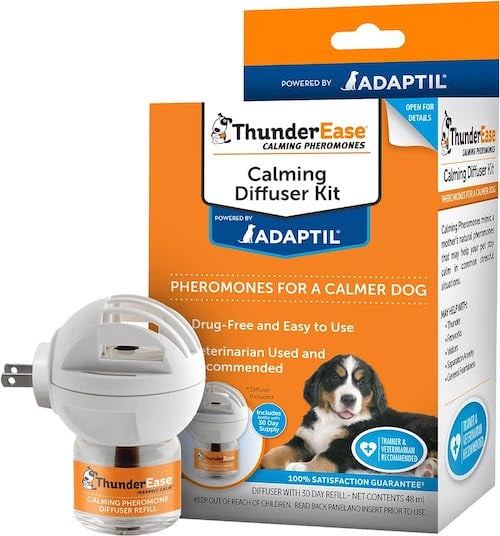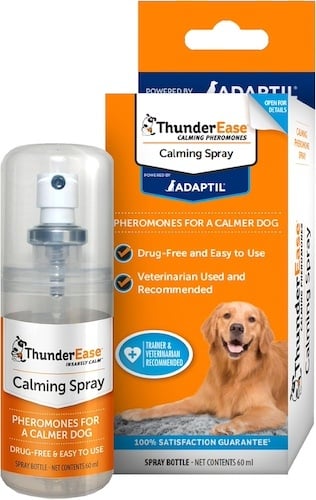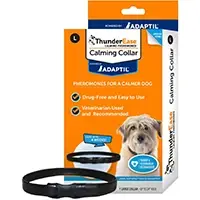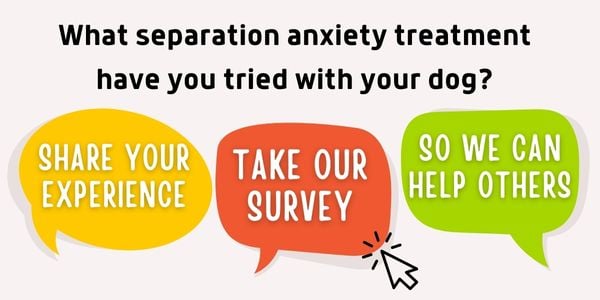 More than ever, we realize that society must address anxiety and overall mental health, especially since 62% of people in a recent survey have some form of anxiety.1
More than ever, we realize that society must address anxiety and overall mental health, especially since 62% of people in a recent survey have some form of anxiety.1
But what about our dog's anxiety?
Since 2020, there has been an increase in each type of anxiety in dogs. The COVID pandemic certainly affected not only our mental health but also the mental health of our pets. We have seen separation anxiety in dogs increase by 700%.
Social anxiety in dogs related to contact with other dogs or cats rose from 16.5% in 2020 to 43.5% in 2022, with the fear of and anxiety about interaction with strangers increasing by 295%. This surpassed the fear of loud noises in dogs, which is usually the leading cause of dog anxiety.2,3
Anxiety disorders in dogs are considered medical conditions because they present with physical symptoms, such as weakened immune systems, urinary tract infections, high blood pressure, chronic diarrhea, and more.
Because anxiety affects the physical health of your dog, not just their mental and behavioral health, it's imperative to address it to keep them healthy.
Table of Contents
We know firsthand how difficult it can be to deal with it day to day. Living with a dog who suffers from fear, anxiety, and stress can be incredibly exhausting and frustrating. We want our dogs to feel happy, safe, and secure.
Preventing our dogs from suffering is the best gift we can give them.
You may be wondering what you can do to help your dog's anxiety. The good news is that there are several options. But generally, for the best results, your dog’s treatment plan will need to be multifaceted.
Let's look at the different types of dog anxiety, and then we'll dive into how to treat dog anxiety and what anxiety medications or supplements may be right for your dog.
What Is Dog Anxiety?
We have all heard the words 'anxiety' or 'anxious' for both humans and dogs, but what does it mean?
Per the Merriam-Webster dictionary, the word anxiety is defined as4:
- “apprehensive uneasiness or nervousness usually over an impending or anticipated ill;”
- “an abnormal and overwhelming sense of apprehension and fear often marked by physical signs (such as tension, sweating, and increased pulse rate), by doubt concerning the reality and nature of the threat, and by self-doubt about one's capacity to cope with it;”
- “mentally distressing concern or interest;”
After reading the definitions of anxiety, most would agree (especially if you suffer from it) that it sounds awful to experience. Imagine being a dog and feeling this way, but being unable to verbalize that feeling.

Types of Dog Anxiety
- Noise anxiety*: Fear and stress reactions to sudden noises, such as fireworks or thunder, or ongoing sounds, such as construction or airplane noise. One study found that 32% of dogs in their group suffered from noise sensitivity.5
- Separation anxiety*: Panic responses and distress when left alone, whether isolation distress (all alone) or separation from a particular person(s), even when others are present. Studies estimate that between 14%–20% of dogs suffer from separation anxiety.6
*There is a relationship between noise anxiety and separation anxiety, meaning we often see these two types of anxiety present in the same dog at a higher rate.7 - Social anxiety: Fear and stress when in social situations, such as around other dogs, people, or a combination of these. This may present as leash reactivity, aggressive behavior (like resource guarding), or trying to avoid or hide.
- Generalized anxiety: A condition where a dog is overall highly sensitive to their surroundings and fearful, stressed, and anxious about a variety of triggers or any change in the usual environment or routine.
- Specific phobias: Some dogs have context-specific anxiety, such as veterinary visits, during baths or grooming, car travel, confinement, handling, certain surfaces, etc.
- Obsessive compulsive disorder (Canine compulsive disorder): This disorder is when a dog exhibits normal dog behaviors but in a repetitive pattern, and to the extreme, so much so that it interferes with their normal ability to function.
This may include spinning, tail chasing, flank sucking, licking themselves (acral lick), fly biting, and more.
Symptoms of Anxiety in Dogs
Physical Symptoms of Anxiety
- Drooling and/or panting
- Fast heart rate (tachycardia) or fast breathing rate
- Pacing
- Urination or defecation in an otherwise housetrained dog
- Excessive shedding
- Dilated pupils and/or fast blinking
- Weight loss
- Gastrointestinal issues (vomiting and/or diarrhea)
- Shaking or trembling
- Skin infections
Behavioral Symptoms of Anxiety
- Trouble concentrating or inattention
- Depression
- Trouble controlling impulses
- "Over-the-top" energy
- Hyperfixation or constantly scanning the environment
- Shut-down behavior
- Trying to run or hide
- Excessive barking
- Excessive or "panicked" jumping and/or mouthing at people
- Yawning or lip-licking
- Humping
- Destructive chewing or scratching
- Aggressive behaviors towards perceived threat or redirected aggressive behaviors to another person or animal
- Repetitive behaviors, such as licking (an object or themselves), in an effort to self-soothe or as a compulsive neurological response

Treatment for Dog Anxiety
The first step to treating your dog's anxiety is to consult with your veterinarian, a canine behavior consultant, or a veterinary behaviorist. They will identify what anxiety your dog is struggling with and what the best way is to manage it.
Treatment for your dog's anxiety typically includes some or all of the following:
- Creating and implementing a behavior modification plan
- Increased exercise and enrichment
- Prescription medication
- Anxiety supplements
- Alternative therapies
Let’s dive deeper into these different parts of treatment so that you can have a better understanding of how they may or may not help your dog.
Training and Behavior Modification for Anxious Dogs
Working through anxiety first requires identifying the cause (or causes) of anxiety for your dog and then managing the environment to reduce the frequency of anxiety occurring while working through behavior change.
Environmental management may mean creating a safe space for your dog, suspending walks or outings, or noise masking with fans or white noise machines. It depends on your dog's anxiety triggers.
A certified canine behavior consultant or veterinary behaviorist can help you with these steps, as well as walk you through the behavior modification exercises. Not all dog "trainers" are the same.
It's crucial with dog anxiety that you connect with a qualified professional who has experience dealing with these types of cases — look for third-party certification for a canine behavior consultant (often designated with CDBC, CBCC-KA, CAAB) or connect directly with a board-certified veterinary behaviorist.
If you are looking for help specifically for separation anxiety, consider a consultant with the CSAT certification, as they specialize in that type of treatment support.
Questions? To chat with a certified canine behavior consultant about your dog's anxiety, Click here
Behavior modification for dog anxiety will primarily rely on desensitization and counterconditioning methods. This means teaching your dog how to feel better around their anxiety triggers, either through systematic and controlled acclimation or by pairing their trigger with high-value reinforcement. Over time and with consistency, a dog becomes better able to cope with their anxiety triggers.
Every dog is different and requires a personalized behavior and training plan. Certain anxieties respond better to desensitization than counterconditioning, and vice versa. In moderate to severe anxiety cases, it's beneficial to bring prescription anxiety medication on board earlier rather than later.
Your behavior consultant or veterinary behaviorist may recommend this before or concurrently with training.
Reduce Anxiety with More Exercise & Enrichment
Regular exercise profoundly impacts people by decreasing stress and anxiety and improving mental and physical health. Well, guess what? The same holds true for dogs. A recent behavioral study in Finland at the University of Helsinki revealed that dogs with active lifestyles had reduced fearfulness, which helped lessen or resolve many behavioral issues.8
When dogs are physically active, the brain produces and releases endorphins. Endorphins help lower stress levels and boost mood. When you are physically active with your dog, it helps boost levels of both your oxytocin (a hormone that aids in bonding and a greater sense of well-being) and dopamine (a ‘feel-good’ hormone), which can help lower stress and anxiety for you both.
Another hormone that is boosted by exercise is serotonin. Serotonin helps make your dog feel calm, relaxed, and sleepy.
Just as anxiety toys help distract and calm people, the same concept can be used for dogs. Giving your dog a puzzle feeder, edible chew, or other enrichment activity can be a natural way to soothe your dog and reduce overall anxiety. Increase your dog's enrichment every day, not just only when the cause of their anxiety is present. For tips and our top recommended enrichment toys, interactive puzzles, and dog chews, check out our articles:
- Dog Enrichment: Toys, Games, and DIY Ideas
- 3 Ways to Calm Down a Hyper or Anxious Dog
- Choosing the Best Interactive Dog Puzzles
- How to Choose Safe Dog Chews
Enrichment toys, puzzle feeders, and dog chews can be used as a distraction for dogs who suffer from low levels of anxiety.
But if you are hoping to use them as part of your behavior modification plan or for severe anxiety, the timing is critical! The anxiety-inducing event must happen before your dog gets the toy or feeder to truly be counterconditioning.
To get enrichment ideas tailored specifically to your dog's breed, take this quiz:
We want to create an emotional association that "anxiety-inducing thing" = good things happen. This is why working with a certified behavior professional is crucial for true progression in the behavior plan.
In an increasing number of anxiety cases, consultants are no longer using stuffed dog feeders or chews in their desensitization protocols, as they can be a distraction that simply delays the appearance of anxiety and is doing nothing to change a dog's emotional response.
In some cases, dogs learn that when you grab their "distraction," the scary thing is about to happen, actually increasing their anxiety. This is why timing is so important in a behavior plan.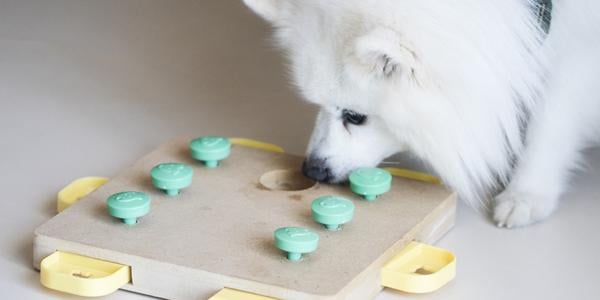
Prescription Medication for Dog Anxiety
It is important to realize that anti-anxiety meds are not a quick fix and that they need to be combined with behavior modification. Though many pet owners are hesitant to use anti-anxiety medications for their dogs, their use is highly beneficial, especially in severe cases, and when combined with an appropriate behavior modification plan.
Prescription anti-anxiety medication can supercharge the behavior modification exercises you do with your dog. Medication helps the balance of chemicals in the brain, making your training more effective. The training repetitions "stick" better when your dog is in a state of mind more conducive to learning and slow thinking.
Medication can also help in your environmental management, increasing the threshold of your dog's anxiety (meaning more time before they react to their particular trigger, reducing the intensity of their reaction, or increasing the speed with which they recover after an anxiety-inducing event).
Since pain in dogs can increase overall stress in the body, cause anxiety, and inhibit training success, the incorporation of NSAIDs (non-steroidal anti-inflammatory drugs) may play an essential role in your dog's treatment plan.
Never give your dog any human medications (prescription or over-the-counter) without express instructions and dosage information from their veterinarian.
Learn about the dangers of doing so here.
Short-Acting vs. Long-Acting Anxiety Medication for Dogs
There are short-acting and long-acting anti-anxiety medications. Many of the medications are FDA-approved for humans for the treatment of depression and symptoms of anxiety, but veterinarians have used them ‘off-label’ for years to treat dogs with different types of anxiety.
Short-acting anti-anxiety medications take effect quickly (generally within 30 to 60 minutes) and last about 4 to 6 hours. They are often used for situational anxieties (thunderstorms or car rides). They can be used to enhance the effectiveness of long-acting medications or during the initial phases of starting long-acting medications until the full effect is reached.
Long-acting medications, such as tricyclic antidepressants (TCAs) or selective serotonin reuptake inhibitors (SSRIs), are given daily, require several weeks or more before they reach full effect, and should not be suddenly stopped. These medications require a wean-off period and a "washout" period (the time between stopping the old medication and starting a new one, generally 2 weeks).
Commonly Prescribed Anxiety Medications for Dogs
Want a quick reference chart for the following anxiety medication information? Our reference chart includes use cases, potential side effects, and other medication notes. Get a free instant PDF download of our Dog Anxiety Medication Chart — just fill out this short form:
Short-Acting Anxiety Medications
- Alprazolam (Xanax®): Prescribed for moderate to severe situational anxiety
- Clorazepate (Klonopin®): Prescribed for anxiety disorders and phobias
- Dexmedetomidine (Sileo®): Prescribed for situational anxieties such as noise phobias and aversions
- Diazepam (Valium®): Prescribed as an anti-anxiety, especially for noise aversion or phobias
- Gabapentin: Prescribed as adjunctive therapy with SSRIs or TCAs for generalized anxiety, impulsivity, noise phobias, and compulsive disorders. May be prescribed for use as needed or in regular doses longer-term.
- Trazodone (Oleptro™ and Desyrel®): Prescribed for separation anxiety, noise phobia, veterinary visits, hospitalization, or travel
- Clonidine (Catapres®, Kapvay™): Prescribed for separation anxiety or phobia-related disorders (e.g., noise phobias), as well as fear-based aggression with identifiable triggers. Is often prescribed in conjunction with a long-acting SSRI medication.
Long-Acting Anxiety Medications
- Amitriptyline (Elavil®, Levate®): Prescribed for separation anxiety or generalized anxiety
- Buspirone (BuSpar®, Bustab®): Prescribed for social situation anxiety (with other animals). Not suitable for situational anxieties such as thunderstorms or human visitors to the home.
- Clomipramine (Clomicalm®, Anafranil®): Prescribed for separation anxiety or situational anxiety
- Fluoxetine (Reconcile®, Prozac®, Sarafem®): Prescribed for separation anxiety as well as other anxiety and behavioral issues
- Lorazepam (Ativan®): Prescribed for situational anxiety
- Paroxetine (Paxil®): Prescribed for generalized anxiety as well as anxiety-related behaviors (fear of noise or self-mutilation)
- Sertraline (Zoloft®): Prescribed for general and separation anxiety, fear-based aggression, and thunderstorm phobia
- Venlafaxine (Effexor®, Effexor XR®): Prescribed for anxiety, fear, and aggression, as well as narcolepsy-cataplexy in dogs.
Questions? To chat with a veterinarian about whether medication may be right for your dog's anxiety, Click here
Potential Benefits of Anti-Anxiety Medications for Dogs:
- A temporary or long-term solution to help dogs while they are in training or behavior modification
- Enhances your dog’s quality of life
- Helps your dog relax
- Helps improve your dog’s family interactions
- Helps decrease and manage destructive or unwanted behaviors
Potential Risks of Anti-Anxiety Medications for Dogs:
- Potential side effects vary with the type of medication, dosage, length of treatment, and the dog's overall sensitivity. Side effects can include sedation, lethargy, a change in appetite, restlessness, stomach upset, increased thirst and urination, and increased respiratory and heart rate.
- Poor response to the medication can lead to delays in improvement since the medication selected may need to be weaned off and then allow a "washout" period.
- Development of dependency with prolonged use.9 When long-acting (and some short-acting) medications are used, dogs can develop withdrawal symptoms when dosages are lowered or stopped.
- Potential interactions with other medications and supplements
- Long-acting medications cannot be abruptly stopped, or they may cause a rebound of anxiety or worsen behavioral problems. Fortunately, the same doesn't apply to short-acting medications.
A Note About Acepromazine ("Ace")
Acepromazine is a medication previously used for many phobias in pets. However, it is slowly going out of favor, and we felt we needed to mention why, as many people still want to use it.
Acepromazine is a phenothiazine-derived psychotropic drug. It is used for dogs as a sedative/tranquilizer, typically prior to anesthesia. Think of it as a "chemical straitjacket." It is a dissociative sedative that makes a dog easier to handle but does nothing to address the underlying fear.
In fact, it can worsen their fears since it scrambles or alters their perception of what is happening and heightens their sensitivity to noise or other anxiety-inducing stimuli. This combination can make the entire situation worse.

Another caution if you intend to use Acepromazine: Some dogs and cats may carry a genetic mutation (MDR1) that makes them sensitive to common medications, including some preventatives. If your pet has this mutation, standard doses could cause severe adverse reactions. An MDR1 test can help your veterinarian tailor safe and effective treatments. Click here for a full list of medications to be cautious about and to order tests.
How Do You Know if a Prescription Anxiety Medication Is Working for Your Dog?
Before a long-acting medication's effectiveness is assessed, dogs typically require treatment for at least four weeks and continued for at least two months following a clear and obvious response. In some cases, dogs can be weaned off these medications, but some may require lifelong treatment.
Once you and your veterinarian have made the decision to start your dog on anti-anxiety medication, it will be important for you to diligently monitor your dog, especially in the early stages, and to communicate frequently with your veterinarian about what you observe.
Keep a daily journal. You will want to document how your dog appears to be feeling. Monitor closely for any of the side effects associated with the medication they are on. If noted, contact your veterinarian.
Establish a scale so you can gauge whether there are improvements in their level of anxiety or reactivity to a trigger. This will help you and your veterinarian determine over time if the medications are improving your dog’s anxiety or if their symptoms are worsening.
Routine lab work (such as complete blood work, chemistry panel, and urinalysis) is important while your dog is on anti-anxiety medications, especially if they have other medical issues of concern.
In cases where your dog needs to be transitioned from one medication to another (i.e., the first was ineffective or caused side effects), the original drug needs to be weaned off, and then a washout period (neither medication is given) between the medications is needed. Follow your veterinarian's instructions for the transition.
Beyond behavior modification and prescription medication, many anxiety treatment options are what we like to describe as "may help, can't hurt." There are limited studies of variable quality for many of these products or treatment modalities, plus a lack of regulation.
It's important to know this as it can help you manage your expectations for certain products or treatments, as well as keep you objective when evaluating whether it's working for your dog's anxiety.
Anxiety Supplements for Dogs

There are lots (and lots) of supplements that are available over the counter that are sold as calming aids. But before jumping and trying them, there are some things you should be aware of.
- Supplements are not well-regulated. Since they are considered animal dietary supplements, the FDA classifies them under pet food. Therefore, there is no need for pre-market approval from the FDA. Only if the product is proven unsafe or ineffective will the FDA pull it.
- The purity, quality, efficacy, and amount of the active ingredient in the product can vary A LOT among manufacturers. That is why it is critical to only use reputable products that use high-quality ingredients. Product labels do not always contain the concentration of the ingredients, or what is stated may be inaccurate. We have a list of reputable products below.
- There is a lack of studies proving the effectiveness of supplements for anxiety. Due to the lack of studies, the dosages for effectiveness are not truly known. And finding the accurate dose for your dog may take time. Some types may take weeks of use before therapeutic results are noted.
- If your dog is on certain medications, anxiety supplements may interact with them and cause side effects.
- Not all dogs react the same way to every supplement, and they don’t work for all types of anxiety.
- They work best in the early stages of anxiety development, where the symptoms are mild to moderate.
After reading that list, you may be thinking you should skip supplements. In my opinion, not at all. I just want you to be aware of some important points so you can make an informed decision, ideally with your veterinarian, prior to starting them.
Potential Benefits of Anxiety Supplements:
- They come in chews or treats, which makes them easier to give to many dogs.
- They do not require a veterinary prescription. (You should, however, always check with your vet before starting any supplement to ensure they will not interact with any current medications or treatments.)
- Typically, they contain natural ingredients if you use a reputable product containing high-quality ingredients.
- They have minimal or no side effects.
- Most are safe for long-term use. (One noted as not safe for long-term use is Kava Kava — see list of ingredients below).
Top Veterinarian-Recommended Anti-Anxiety Supplements:
Active Ingredients to Look For in Anti-Anxiety and Calming Supplements for Dogs
- Alpha-casozepine: Found to reduce anxiety and fear of strangers.10
- Chamomile: Found to have a gentle, relaxing effect that helps reduce anxiety, especially when combined with other herbs such as valerian. It has anti-inflammatory properties, which also help lower anxiety since anxiety and inflammation are closely linked within the body. When pets are anxious, they typically have gastrointestinal issues. Chamomile has antispasmodic qualities that help ease those issues, which in turn aid your dog during an anxiety episode.
- CBD: Has been found, when properly dosed, to reduce anxiety and ease pain.11, 12, 13, 14 Regulation of CBD for dogs is minimal, so it's important you do your due diligence before trying this out with your dog. Check out our article, What to Know if You Want to Give Your Dog CBD for tips on where to start.
- GABA: Found to improve emotional state, slow down the brain, relax the nervous system, and reduce anxiety.15 GABA is a significant neurotransmitter in a dog's brain that decreases or inhibits the activity of nerve cells. This slows down the brain, allowing the nervous system to relax.
- Kava Kava: Has been found to ease or reduce noise and travel anxiety, fear response, insomnia, stress, pain, or inflammation. This should only be used short-term, as long-term use can lead to liver damage.16, 17, 18, 19 As with all supplements, check with your veterinarian before giving this to your dog.
- L-arginine: Found to ease anxiety, especially that associated with cognitive dysfunction disorder.20
- L-theanine: Found to reduce fear of strangers, noise, and storm phobia.21, 22
- L-tryptophan: Found to help dogs cope with stress.23
- Lemon balm: Found to help treat anxiety and excitability because of its sedative effects cause calming and relaxation.24
- Magnolia Officinalis: Found to have anti-anxiety effects and may help with fear-related signs of thunderstorms.25, 26, 27 It binds to selective targets in the central nervous system that are linked to stress.
- Melatonin: Found to help with situational fear (vet visits, storms, or fireworks) and anxiety. Aids in sleep for dogs that are restless overnight.28 If you want to try melatonin for your dog, make sure it doesn't contain xylitol, an ingredient that is HIGHLY TOXIC to dogs. Learn more about the dangers of xylitol here.
- Passiflora incarnata (passion flower): Found to cause relaxation by strengthening the effectiveness of GABA brain receptors and decreasing tension.29, 30
- Phellodendron Amurense: Found to protect the brain from the negative effects of stress and help mood disorders. Helps with fear-related signs of thunderstorms.31
- Valerian root: Found to help pets sleep and may ease anxiety.32
Additional Supplements and Products with Calming Effects:
- Probiotics: As more studies are conducted, there appears to be a link between gut flora and emotions. Research done at the Purina Institute showed that certain probiotics modify the gut microbiome, decrease anxiety, and impact behavior.33
See our top recommendations for prebiotics and probiotics for dogs here. - Pheromones: Pheromones are chemical messengers that, when released, have an impact on a pet’s behavior and emotional state. They can help dogs feel more secure and comfortable. Studies have found it to have a positive impact on dogs with separation anxiety and noise phobia.34
A popular dog-appeasing pheromone brand is ThunderEase (powered by Adaptil), available as a diffuser, travel spray, or wearable collar.
- B Vitamins: This vitamin is critical to the nervous system for it to function properly. It helps decrease anxiety by promoting the production of serotonin, which creates a calming effect. Your veterinarian can test your dog to determine if they are deficient in B vitamins. If they are, a vitamin supplement or injection will be prescribed.
- tPEMF Treatment: A recent product on the market for dog anxiety, Calmer Canine®, uses targeted pulsed electromagnetic field (tPEMF) signals to help an anxious brain return to a balanced emotional state.35
Preventive Vet team members have used this for their own dogs, and it is often recommended by our team's canine behavior consultant as an alternative to prescription medications. - Flower Essences: Rescue Remedy® Pet was developed to help ease the anxiety associated with separation, travel, noise, and stressful events. It contains a blend of five flower essences (Rock Rose, Impatiens, Clematis, Star of Bethlehem, and Cherry Plum). While there is limited scientific data on its effectiveness for dogs, it is very popular with many pet owners.
Alternative Treatments for Dog Anxiety
 Acupuncture: With regular treatments, it has been found to help dogs with anxiety since it helps release feel-good endorphins.
Acupuncture: With regular treatments, it has been found to help dogs with anxiety since it helps release feel-good endorphins.- Massage: Massage helps reduce heart rate and blood pressure, eases pain and tension, and calms the nervous system.
- Calming music: Musical therapy has been found to lessen stress and anxiety. Though each dog can exhibit distinct preferences, classical, reggae, and soft rock appear to be the most effective. Learn more about how to use music to calm your anxious dog here.
- Aromatherapy: Your dog has an acute sense of smell, with more than 40 times the scent receptors than humans. The olfactory bulb is linked to the limbic system, which is responsible for memory and emotions. A sense of well-being and calm can be encouraged by essential oils used in aromatherapy.36, 37 When the appropriate pure, medical-grade essential oils are used properly, they can be a natural calming and anti-anxiety effect on your dog.
Check out our list of safe essential oil recipes to use around your dog. - Reiki: Science-based energy medicine that can help ease a dog’s anxiety and stress by creating a profound state of relaxation.38
- Calming wraps or wearables: Pressure clothing or wraps, such as the Thundershirt or Tellington TTouch® Wraps, are meant to make your dog feel like they are being hugged, and they apply pressure to trigger points meant to ease fear or phobias. While the studies evaluating these products are generally inconclusive, many pet parents felt that the vests did have a beneficial effect on their dogs.39 Personally, I can say I had many clients that used them, and they helped. But I also had clients who felt they didn’t.
Be sure that the pressure clothing fits properly. It should not be restrictive, and do not leave your dog unsupervised while they are wearing it. It is important to keep in mind that some dogs may find pressure clothing to be uncomfortable or fear-provoking. Therefore, monitor your dog closely when first trying the clothing, and do not force them to continue wearing it if they seem uncomfortable. - Other calming aids: Think of these as your dog's "security blanket." It may literally be a blanket or perhaps another toy or their calming bed. The Snuggle Puppy is a popular calming aid that many dogs find comforting as a puppy when they first leave their littermates, but it may help your dog feel better even as an adult. Other options include calming beds, designed to be extra cozy and nest-like for a calming effect.
As with any behavioral issue, there is never a one-size-fits-all solution for treating your dog's anxiety, and what once worked may eventually stop working. It is important to be patient, open-minded to different options, and diligent with continuous treatment. The payoff is well worth the work — a happier, healthier dog!


